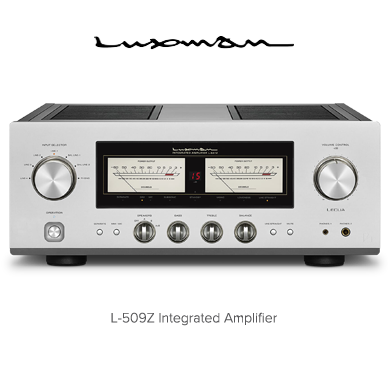All-Analog, Completely Balanced, Dual-Mono, Japanese-Made Marantz PM-10 Reference Integrated Amplifier Delivers Benchmark Purity, Drive, Grip, Clarity and Dynamics
We'll cut to the chase: The all-analog, completely balanced, dual-mono Marantz PM-10 is is essentially a preamplifier and pair of monoblock power amplifiers in a single box. Via forward-thinking, full-bridge analog switching amplification that features four switching power-amp channels in bridged mode, PM-10 delivers 200Wpc into eight ohms and a whopping 400Wpc into four ohms. Its instantaneous high-current capability allows it to effortlessly drive almost any speaker around while simultaneously eliminating noise and providing reference-level grip and dynamics. PM-10's equally advanced True Balanced Concept realizes ground-free signal management from the input all the way to the output. Such meticulous engineering and benchmark quality even extend to the newly devised and Marantz-exclusive SPKT-100+ speaker terminals, comprised of high-purity solid copper. With PM-10, no expense is spared – and no audio detail left uncovered. You'll realize this the moment you hear it.
Featuring separate power supplies for the preamplifier and each of the power-amplifier channels, PM-10 performs with utmost purity by permitting your delicate audio signals to pass through the preamplifier independent of the demanding output stages. A dedicated supply for the microprocessor controlling the volume functions and input selection prohibits any noise from the control section seeping into the audio path. Marantz's proprietary HDAM-SA3 modules, built from discrete components, fuel the preamplifier and deliver outstanding fidelity. Two sets of balanced inputs join line-level inputs, with the signal always converted to balanced before passing through the amplifier. If you value stunning naturalism and purity, PM-10 shares your interests. As such, PM-10 lacks a DAC or digital volume control – features that add noise and potential interference, both negative characteristics at odds with the all-analog PM-10's purist principles and goals.
For the ultimate in clarity and transparency, PM-10 can operate in "Purest Mode." This function deactivates any superfluous circuits and provides the signal the cleanest-possible pathway through the amplifier. Want to use PM-10 as a dedicated power amplifier? No problem. A Power Amp Direct input takes the signal directly from the input section to the power stage. For stellar vinyl LP playback, PM-10 includes a discrete MM/MC phono preamplifier housed in its own shielded case. A double-layer copper-plated chassis, 5mm-thick aluminum top lid, double-thick copper PCB in the output section and main power supplies, and aluminum die-cast feet serve as further evidence that PM-10 goes over the top inside and out. Backed by Music Direct's Money-Back Guarantee and Marantz's three-year parts-and-labor warranty (for refurbished Reference Series products), PM-10 is indeed the New Reference.
Dual-Mono Design with Separate Power Supplies for Preamp and Each Power Amp Channel
Amplifiers usually use a single transformer with separate power-supply regulation for the preamplifier and power amplifier sections. PM-10 takes things much further. A dual-mono design, it boasts separate power supplies for the preamplifier and each of the power amplifier channels. One transformer is dedicated to the preamp to ensure the delicate signals passing through that section of the amplifier aren't affected by the demands of the high-power output stages. There's also a dedicated supply for the microprocessor controlling volume adjustment, input selection, and more, meaning no noise from the control section finds its way in to the audio path.
Purely Analog Amplifier Includes "Purest Mode" and Power Amp Direct Ability
PM-10 is a purely analog amplifier. Many contemporary designs include digital-to-analog conversion (DAC) capability, or adopt digital amplification and volume control. Marantz keeps things as clean and simple as possible. While it may seem convenient to have a DAC in the amplifier, digital circuitry is by its very nature noisy (in the electrical sense) and can interfere with the delicate analog signals passing through the amp. That's why Marantz chose to design its Premium Series with any digital-to-analog conversion in its SACD/CD or network music players, keeping its amplifiers as pure and clean as possible. To make the most of that purity, PM-10 can work in "Purest Mode." When engaged, this option deactivates any superfluous circuits, giving the signal the cleanest-possible path through the amplifier. There's also a Power Amp Direct input that takes the signal straight from the input section to the power stage to let the unit work as a pure power amplifier.
The Many Benefits of True Balanced Concept and Bridged Amplification
For PM-10, Marantz wanted the purest sound – plus the power and dynamics to drive and control the world's most demanding speakers. To achieve this, engineers continued the balanced working found in the preamp stage right through to the power amplifier stage to its speaker outputs – and also adopted bridged working to develop the power required while maintaining that balanced design. This True Balanced Concept realizes a ground-free signal management from the input to the output. So, what is a bridged amplifier? In a conventional amplifier, one speaker is driven by the positive and negative part of one single output stage per channel. A bridged amplifier does things differently, using two separate amplifier stages per channel to drive one speaker. In other words, one amp pushes the speaker cones and domes, while the other pulls them back. With much greater control over the way the speaker drive units behave, in that the amplifier can make them start and stop moving much more precisely, translates to enhanced definition and speed. Your system will be able to play music with much better rhythmic and spatial controls, not to mention more realistic vocal and instrumental resolution. In PM-10, the bridged amplifiers in the power output stage – a total of four amplifier channels – allow this control to be combined with huge power output. That ensures not just the power to drive even big, power-hungry speakers to high levels while keeping the sound clean and distortion-free, but also the grip to make sure those speakers are doing just what the music demands.
Reference-Setting Internal Components and Build Quality
Marantz has long built a reputation for choosing the best-possible components for its Premium Series products. If it can't find what it wants, it designs and builds the required part. That thinking informed its Hyper Dynamic Amplifier Module (HDAM). Unhappy with the audio quality available from "amplifier on a chip" IC components, the company designed its own alternative in the form of a miniature amplifier module built entirely of discrete components. In PM-10, the latest-generation HDAM-SA3 is used as part of a current-feedback topology designed for the widest possible frequency and dynamic ranges – just the thing for today's ultra-high-resolution audio formats – and aided by ultra-fast custom-made block capacitors for the fastest-possible response to demands for high current. The same current-feedback design is applied to the built-in MM/MC phono preamplifier.
Why Balanced Is Better
The benefits of balanced audio layout have long been understood. Unlike a conventional layout, where one half of the signal path is in the ground plane of either an amplifier or a cable, balanced working uses two conductors or paths – one for positive, the other for negative – and an entirely separate ground to protect them. The benefit in cables is any external interference will affect both positive and negative conductors, but since the signals they are carrying are the mirror image of each other, they will mutually cancel out any effect. The same is true when balanced working is applied to audio circuitry. Not only does this mirror imaging of the layout, in which identical components are handling the positive and negative legs of the signal, cancel out any potential interference – it also means any noise or errors introduced in the circuitry will also be cancelled out. An additional benefit is that balanced working also uses stronger signals than unbalanced designs, as both halves of the circuit are active. Rather than just having one half pushing and the other just providing the ground, balanced is a "push pull" operation. A stronger signal means one less susceptible to any outside interference. The more signal there is, the less obvious any noise will be. PM-10 uses a fully balanced layout from the input section all the way through to the final power amplifier section. It has two sets of balanced inputs, and also conventional unbalanced line-level inputs (plus a high-quality phono preamplifier), with the signal from these inputs being converted to balanced working before being passed through the amplifier. By keeping the signal balanced all the way through the amplifier, and combining that with optimized power supply design, Marantz engineers achieved maximum noise rejection throughout the audio path and the highest-possible signal purity.
Number of terminals: 4
Power Output (8/4 Ohm RMS): 200 W/400 W
Frequency Response: 5 Hz - 50 kHz
Total Harmonic Distortion: 0.005 %
Damping Factor: 500 dB
Input Sensitivity:
MM: 2.6 mV/47 kohm
MC:
280 μV/ 33 ohm (MC-LOW)
280 μV/ 133 ohm (MC-HIGH)
Signal to Noise Ratio:
MM: 88 dB
MC: 76 dB
Input Sensitivity:
High level: 440 mV/20 kohm
Balanced High level: 880 mV/40 kohm
Signal to Noise Ratio: 111 dB (2V input/rated output)
Input Sensitivity: 1.5 V/20 kohm
Signal to Noise Ratio: 113 d B
Power Consumption: 270 W
Standby Consumption: 0.3 W
Maximum Dimensions (WDH): 17.3" x 17.8" x 6.6"
Weight: 47.4 lbs.
![]() User Manual (PDF, 1.7 MB)
User Manual (PDF, 1.7 MB)






































